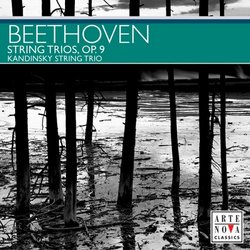| All Artists: Ludwig van Beethoven, Kandinsky String Trio Title: Beethoven: String Trios, Op. 9 Members Wishing: 0 Total Copies: 0 Label: Arte Nova Classics Original Release Date: 1/1/2005 Re-Release Date: 8/9/2005 Genre: Classical Styles: Chamber Music, Historical Periods, Classical (c.1770-1830) Number of Discs: 1 SwapaCD Credits: 1 UPC: 723721138356 |
Search - Ludwig van Beethoven, Kandinsky String Trio :: Beethoven: String Trios, Op. 9
 | Ludwig van Beethoven, Kandinsky String Trio Beethoven: String Trios, Op. 9 Genre: Classical
|
Larger Image |
CD Details |
CD ReviewsThe End and the Beginning Robin Friedman | Washington, D.C. United States | 10/11/2008 (5 out of 5 stars) "Beethoven composed five works for the relatively unusual form of string trio, violin, viola, and cello. His first two works in the form, opus 3 and opus 8, are in the character of divermentos, popular somewhat lightweight pieces. Beethoven's made his final venture into the string trio form in 1798 at the age of 28 with the three trios of opus 9 which brought this difficult genre to a high level. Upon completing the set, Beethoven began work on the six string quartets which were published as opus 18 in 1801. These quartets are generally regarded as the best works of Beethoven's first period. He never returned to the genre of string trio. Few composers have attempted works in the form since. Beethoven's opus 9 trios, together with Mozart's K. 563, are the only major works in this form.
Beethoven's opus 9 trios are infrequently performed. They are recorded here in an excellent rendition by the Kandinsky String Trio on the low-priced Arte Nova label. The Kandinsky Trio consists of two first-chair players from the Radio Philharmonic Orchestra, Hanover: concertmaster Kathryn Rabus and cellist Nikolai Schneider, together with violist Hartmut Rhode, professor at the University of the Arts in Berlin and at the Royal Academy of Music in London. The recording dates from 2001. Beethoven's opus 9 string trios retain some of the lyrical, divermento-like character of his earlier efforts, but they are remarkably tightly-written varied pieces. Beethoven uses to the utmost the expressive possibilites of the three instruments, with ensemble passages alternating with solo passages of great intricacy. The music ranges from the tragedy to boisterous humor. The works are highly integrated, both as individual trios and as a set of three. The first of the opus 9 set, in G major, is a large-scaled dramatic work, the longest of the set. It opens with an expansive adagio which sets the stage for the remainder of the trio and for the set as well. Following the adagio, the opening allegro con brio moves broadly between a large-scaled theme and a lyrical second theme. The second movement is also large and lengthy, as Beethoven contrasts the extroverted opening movement with a slow movement of a pensive character. It features a lyrical cello solo about midway. The third movement is a brusque scherzo with another singing passage for the cello in the trio. The rondo finale is a humorous and lively perpetuum mobile that shows Haydn's great and continuing influence upon Beethoven. The second string trio is in D major and contrasts with the first in its quietly instrospective character. Beethoven had a great gift for song-like writing when he wished to use it. His melodic genius is on full display in this trio, especially in the second and fourth movements. The four movements of this work are basically complementary to each other rather than contrasting, as in the first trio. The opening movement is introspective and moderately paced. The second movement is a bittersweet, graceful movement in G minor with another lovely melodic line for the cello. The third movement is a subdued minuet, unlike the scherzo of the first trio. It leads into a rollingly lyrical and extended finale -- reminding me of the lyricism of the finale of Beethoven's early cello sonata, opus 5 no. 2. Beethoven frequently used the key of C minor to express feelings of tragic passion. His early C minor works include the piano trio, opus 1 no. 3, the piano sonata opus 10 no. 1, the string quartet opus 18 no. 4 and the Sonata Pathetique, opus 13. The string trio in C minor opus 9 no. 3 belongs in this high company. It is the capstone of Beethoven's efforts in the string trio form. The trio is intense throughout with a tautly tragic and angular opening movement in the minor. The adagio which follows begins with choral music in the major key, but it builds to a large jagged c minor climax before the initial music returns with great embelishments. After a short, rushed c minor scherzo, the trio concludes with a yearning and sad presto finale in the minor key. The work comes to an end in a pianissimo, resigned passage in c major. The opus 9 string trios ended Beethoven's work in this form but began his work on string quartets, which continued for the rest of his life. These relatively little-known trios will delight listeners who love Beethoven's quartets, his considerably better-known piano trios, and his other chamber music. Robin Friedman" |

 Track Listings (12) - Disc #1
Track Listings (12) - Disc #1